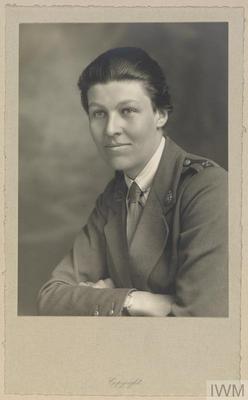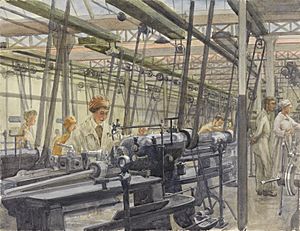Beatrice Ethel Lithiby facts for kids
Quick facts for kids
Beatrice Ethel Lithiby
|
|
|---|---|

Lithiby c.1918
|
|
| Born | 4 December 1889 |
| Died | 25 July 1966 (aged 76) |
| Nationality | British |
| Education | Royal Academy Schools |
| Known for | Painting, stained glass, church furnishings |
| Awards | MBE, OBE |
Beatrice Ethel Lithiby (born December 4, 1889 – died July 25, 1966) was a talented British artist. She was known for her beautiful paintings and for designing stained glass windows. She also created special furnishings for churches. Beatrice Lithiby served in the British Army during both World War I and World War II. In World War I, she even worked as a war artist for the Imperial War Museum, capturing important moments through her art.
Contents
Beatrice Lithiby: Artist and War Hero
Her Early Life and Art
Beatrice Lithiby was born in Richmond, which was then in Surrey and is now part of London. Her father, John Lithiby, was a barrister, which is a type of lawyer. Her mother was Ethel Stewart née Smith.
Beatrice studied art at the Royal Academy Schools. While she was a student, she planned to marry a fellow student named Frank Skinner. Sadly, Frank was killed in July 1916 during a big battle called the Somme. Beatrice never forgot him. Every year, she would place a special notice in The Daily Telegraph newspaper to remember him on the anniversary of his death.
Serving in World War I
During the First World War, Beatrice Lithiby joined the Women's Army Auxiliary Corps (WAAC). This was a group where women helped the army. She joined on August 4, 1917, as an assistant administrator. This rank was similar to a second lieutenant.
She then served in France for about 18 months with the Queen Mary's Army Auxiliary Corps (QMAAC). She was promoted several times, eventually reaching a rank similar to a captain. In 1919, she was given a special award called the Member of the Order of the British Empire (MBE). This award was for her important services during the war. She officially left the QMAAC in December 1919.
An Artist for the Imperial War Museum
In February 1919, Beatrice offered to draw and paint the women of the QMAAC who were still in France. She wanted to record their work before they returned home. The Imperial War Museum liked her idea.
Beatrice spent six more months in France. She made sketches and watercolour paintings. She showed the women working in camps in places like Dieppe and Rouen. They were doing many jobs, like looking after cemeteries and clearing old battlefields.
At first, Beatrice agreed to a very small payment. But after three months, the museum told her they couldn't pay her at all because of budget cuts. Even so, Beatrice kept working. She later gave 20 of her watercolours to the Imperial War Museum. These paintings are very special because they show the important work women did in the military during that time.
Art and Service After WWI
From 1920 to 1939, Beatrice Lithiby worked as an artist. She painted people and landscapes, and also created large wall paintings called murals. She often showed her art at the Royal Academy and the Royal Society of British Artists. She became a member of the Royal Society of British Artists in 1930.
She also showed her work with other art groups. Beatrice created stained-glass windows and church furnishings for churches in Britain, Japan, and South Africa.
For many years, Beatrice lived in Wantage, Berkshire. Her home and art studio were near an Anglican convent, which is a place where religious women live. Beatrice was a very religious person herself. She even wrote a history book about the Wantage parish church.
Her Role in World War II
When the Second World War began, Beatrice Lithiby rejoined the British Army. She joined the Auxiliary Territorial Service (ATS) in May 1941. This was another women's army service. She started as a second subaltern, similar to a second lieutenant.
By December 1943, she had risen to a senior rank, similar to a major. She even held the temporary rank of chief commander, which is like a lieutenant colonel. In 1944, her MBE award was upgraded to an Officer of the Order of the British Empire (OBE). This was another high honor for her service.
Beatrice Lithiby passed away on July 25, 1966. This was exactly 50 years after the death of Frank Skinner, the man she had planned to marry. She never married.
See also


